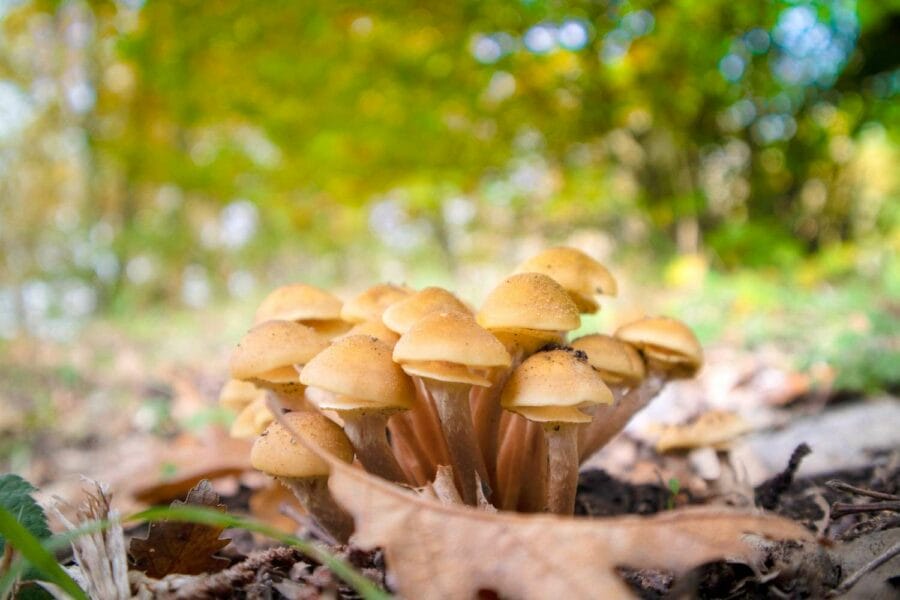Psilocybin, a psychoactive compound prevalent in magic mushrooms, is frequently used for its euphoric and hallucinatory effects.
Besides its mind-altering properties, research has been conducted on the potential benefits of this compound for chronic pain relief.
This article will discuss a case study that investigates the potential of microdosing mushrooms in managing chronic pain.
Key Takeaways:
- Microdosing mushrooms may potentially provide immediate and sustained pain relief.
- Compared to traditional pain medications, microdosing psilocybin usually has no side effects when used in small quantities.
- Psilocybin interacts with the serotonin 2A (5-HT2A) receptors, potentially easing pain and other conditions.

The Study
Dr. Matthew Lyes and his team from the Division of Pain Medicine at the University of California, San Diego conducted the study titled “Microdosing Psilocybin for Chronic Pain: A Case Series“. The research centered on three patients self-administering small doses of psilocybin to manage their chronic pain symptoms.
Three Patients, One Result – Chronic Pain Relief
Patient # 1
| AGE/ GENDER: | 37 Male |
| PAIN TYPE: | Neuropathic pain located below a spinal cord injury site. |
| PAIN INTENSITY: | Initially 4 to 5/ 10, increasing to 8/ 10 later in the day |
| PSILOCYBIN DOSAGE: | 250 mg of ground mushroom for less than 6 months |
| OUTCOME: | Discontinuation of prescribed pain medication, decrease in muscle spasms, and improved bowel function. No signs of rebound pain or withdrawal symptoms were reported. |
| The patient reported that unlike his regular medications which only seemed to dull the pain, psilocybin effectively eliminated it, reducing his average pain level from 5 to 0. | |
Case Study: Subject #2
| AGE/ GENDER: | 69, Female |
| PAIN TYPE: | Complex Regional Pain Syndrome (CRPS) |
| PAIN INTENSITY: | Typically fluctuates between 5 and 7 out of 10, but may increase during activity and pain flare-ups |
| PSILOCYBIN DOSAGE: | Regular intake of 500 mg daily for 7 to 10 days with intermittent rest periods (2 to 3 days) over one year. Dosage is increased to 750 mg to 1 gram during periods of intensified pain |
| EFFECT: | Results in an 80% reduction in pain for about 3-4 hours, after which pain gradually reverts to the initial level after 12 hours. Complete pain relief (90%-100%) is experienced for 6-8 hours, before returning to the initial level after 18 hours. |
| The patient reports a decrease in appetite without the presence of nausea. Instances of disorientation or instability while walking are observed when the dosage is heightened (750 to 1000mg). | |
Case Study: Subject # 3
| AGE/ GENDER: | 40, Female |
| PAIN TYPE: | Lumbar radiculopathy and neuropathic pain |
| PAIN INTENSITY: | 8 out of 10, rising to 10 out of 10 during physical activities |
| PSILOCYBIN DOSAGE: | 1000 mg from a mushroom chocolate bar administered bi-monthly. |
| EFFECT: | Significant alleviation from pain without any psychoactive consequences. Enhanced flexibility and functionality is observed. Pain gradually reverts to the initial level over a span of 2-4 weeks. Recurring dosage aids in better pain management. |
| The patient does not present any significant physical, cognitive, or behavioural side effects. Mood remains mainly stable. The regular dosage of SSRI for depression management is maintained throughout the psilocybin treatment phase. | |
Comprehending Pain Management via Psilocybin
Continuous signals of somatic and visceral pain strengthen specific neural pathways due to peripheral and central sensitization, resulting in a prolonged experience of physical and emotional pain. Psychedelics such as psilocybin stimulate 5-HT2A receptors, potentially resetting neuropathy-associated brain regions.
One patient reported sustained pain relief for several weeks. This suggests that direct stimulation of 5-HT2A receptors can lead to central regulation of pain perception and adaptability of synapses.
Possible Side Effects of Psilocybin Compared to Traditional Pain Killers
| PSILOCYBIN (Based on Studies) | TRADITIONAL PAIN KILLERS |
| Muscle spasms | Nausea |
| Decreased hunger | Stomach discomfort |
| Disorientation | Migraines |
| Unsteady gait | Addiction risk |
| No mood changes | Drowsiness |
Potential Future Studies on Psilocybin
The research team, after studying the experiences of three subjects, have suggested certain areas for further exploration due to potential benefits.
- Small amounts of psilocybin could provide immediate and possibly long-lasting relief from neuropathic pain, without causing physical tolerance or addiction.
- Research the effects of different treatment methods combined with psilocybin. For example, patient #3 reported an increased pain-relieving effect when psilocybin was used in conjunction with physical therapy.
- Even without psychotherapy, small doses of psilocybin could provide relief from pain, as demonstrated in this case study. The researchers suggest that incorporating therapeutic guidance could potentially enhance or prolong the beneficial effects.
Constraints of the Study
Despite the encouraging findings in the patients, it’s crucial to acknowledge the limitations identified in the study.
- The limited number of participants may not accurately represent all individuals experiencing neuropathic pain.
- The study did not include any participants who did not respond to psilocybin.
- No assessments were conducted before and after treatment to measure the impact of psilocybin on psychiatric disorders such as depression and anxiety.
- Most of the data was self-reported by the participants.
- The presence of the interviewer and potential bias related to psilocybin could have influenced the participants’ responses.
- The study did not account for the influence of the placebo effect.
- The study did not establish the quantity of psilocybin in each mushroom.
Utilizing Mushrooms for Microdosing
According to this study, participant Patients #1 and #2 consumed a microdose of psilocybin in the form of powdered, dried mushrooms. Conversely, patient #3 incorporated it with chocolate. There are numerous psilocybin microdosing products available, and we have gathered a list of some of them below.
Dried Mushroom Varieties
Although the specific strain was not disclosed in the study, the following one is recommended for novice users.
- Golden Teacher: A prevalent strain of psychedelic mushrooms frequently encountered.
- Amazonian Cubensis: Recognized for its user-friendly properties. It can yield cognitive enhancements.
- Cambodian: Microdosing with Cambodian cubensis mushrooms can boost concentration, social awareness, and mood.
Microdose Capsule Options
- Euphoria Psychedelics – Micro Calm Capsules: This concoction comprises Ashwagandha, Reishi, CBD, Valerian root, and Psilocybin Mushrooms, which are all scientifically established to alleviate anxiety and stress.
- Ground Sounds – Microdose Capsules – Champion Lover: This compelling blend provides three dosage alternatives: 50mg, 100mg, or 250mg of pure psilocybin combined with reishi, cacao, cordyceps, and maca.
- Kind Stranger – Brighten Capsules 250mg: These capsules include the Golden Teacher strain, renowned for promoting clarity, amplified creativity, and improved focus.
Mitigating Pain with Psilocybin
Although research into the analgesic properties of mushrooms is still preliminary, anecdotal reports and small-scale studies are offering promising indications.
Such instances underscore the urgency for more extensive investigation into the potential advantages of psilocybin, class=”wp-block-list”>
Especially in the realm of managing chronic pain.
Before the wide acceptance of psilocybin as a pain reliever, the hopeful tales from case studies brought solace to those struggling with chronic pain.
Frequently Asked Questions
What effects does microdosing psilocybin produce?
Psilocybin primarily stimulates a serotonin receptor known as “5-HT2A” in the prefrontal cortex, generating two main outcomes:
- Induction of “Brain-Derived Neurotrophic Factor” (BDNF)
- Enhanced “Glutamate” transmission
Besides, psychedelics promote interaction between brain regions that usually don’t communicate. This distinctive connectivity arises from the ability of psychedelics to decrease the activity of the “Default Mode Network” (DMN), which is associated with numerous cognitive functions like daydreaming, introspection, and pondering the past and future.
What is the most recognized benefit of microdosing mushrooms?
Microdosing might enhance mood, productivity, creativity, and focus. Its most extensively researched benefit is its effect on mental health.
In November 2022, COMPASS Pathways, a company specializing in mental health, disclosed the findings of their extensive phase 2b trial, a randomized and double-blind study. Their investigation indicated that a single psilocybin dose significantly reduced depressive symptoms compared to a placebo. Participants who received a larger 25-milligram dose showed a prolonged antidepressant response at the twelve-week follow-up.
A study reported in the Psychiatry Research Journal suggested that psilocybin is more efficacious than traditional antidepressant treatments.
How can you determine your dosage?
Start with a 0.1-gram dose of psilocybin mushrooms on day one. If the expected effects are not obtained, you can incrementally augment your dose by 0.05 grams on subsequent microdosing days until you find your ideal dosage.
Those with previous psychotropic drug usage may need to increase the dose to 0.5 grams to obtain the desired effects.
What preparations should be made before consuming mushrooms?
class=”wp-block-list”>What is the suggested frequency for taking mushroom microdoses?
There are several well-accepted regimens that propose structured microdosing schedules for psychedelics. These regimens primarily differ in the number of “off” days they include, which are the days you abstain from microdosing.
The most commonly suggested regimens recommend 1-3 rest days between microdoses. This aligns with the body’s natural tolerance mechanisms. The three regimens discussed in this context are the Fadiman Protocol, the Stamets Stack, and intuitive microdosing.




